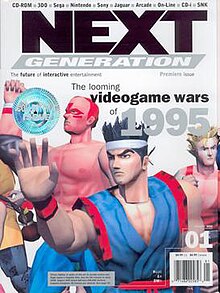|
Next Generation (magazine)
Next Generation was a US video game magazine that was published by Imagine Media (now Future US).[2] It was affiliated to and shared content with the UK's Edge magazine. Next Generation ran from January 1995 until January 2002. It was published by Jonathan Simpson-Bint and edited by Neil West. Other editors included Chris Charla, Tom Russo, and Blake Fischer.[3] Next Generation initially covered the 32-bit consoles including 3DO, Atari Jaguar, and the then-still unreleased Sony PlayStation and Sega Saturn. Unlike competitors GamePro and Electronic Gaming Monthly, the magazine was directed towards a different readership by focusing on the industry itself rather than individual games. Publication historyThe magazine was first published by GP Publications up until May 1995 when the publisher rebranded as Imagine Media. In September 1999, Next Generation was redesigned, and its cover name shortened NextGen. A year later, in September 2000, the magazine's width was increased from its standard 8 inches to 9 inches. This wider format lasted less than a year. The brand was resurrected in 2005 by Future Publishing USA as an industry-led website, Next-Gen.biz. It carried much the same articles and editorial as the print magazine, and reprinted many articles from Edge, the UK-based sister magazine to Next-Gen. In July 2008, Next-Gen.biz was rebranded as Edge-Online.com.[4] Content
Next Generation's content did not focus on screenshots, walkthroughs, and cheat codes. Instead the content was more focused on game development from an artistic perspective. Interviews with people in the video game industry often featured questions about gaming in general rather than about the details of the latest game or game system they were working on. Next Generation was first published prior to the North American launch of the Sega Saturn and Sony PlayStation, and much of the early content was in anticipation of those consoles. Apart from the regular columns, the magazine did not use bylines. The editors explained that they felt the magazine's entire staff should share the credit or responsibility for each article and review, even those written by individuals.[5] The review ranking system was based on a number of stars (1 through 5) that ranked games based on their merits overall compared to what games were already out there. Next Generation had a few editorial sections like "The Way Games Ought To Be" (originally written every month by game designer Chris Crawford) that would attempt to provide constructive criticism on standard practices in the video game industry. The magazine's construction and design was decidedly simple and clean, its back cover having no advertising on it initially, a departure from most other gaming magazines. The first several years of Next Generation had a heavy matte laminated finish cover stock, unlike the glossy paper covers of its competitors. The magazine moved away from this cover style in early 1999, only for it to return again in late 2000. Issue history
References
External links |
||||||||||||||||||||||||||||||||||||||||||||||||||||||||||||||||||||||||||||||||||||||||||||||||||||||||||||||||||||||||||||||||||||||||||||||||||||||||||||||||||||||||||||||||||||||||||||||||||||||
